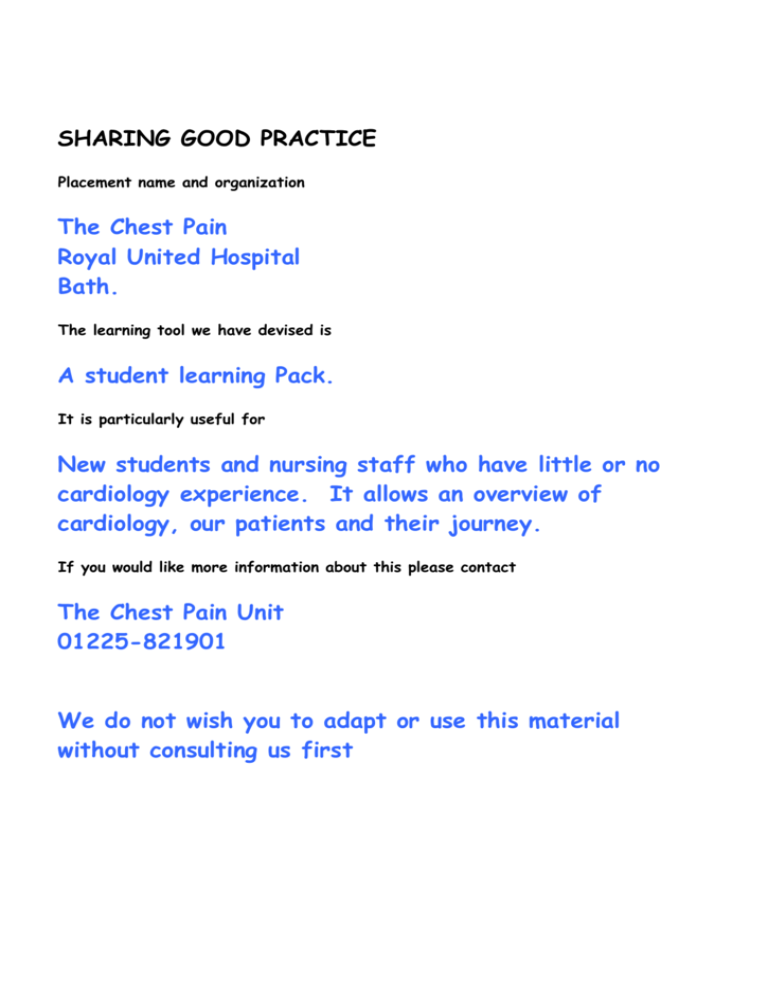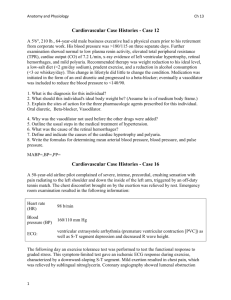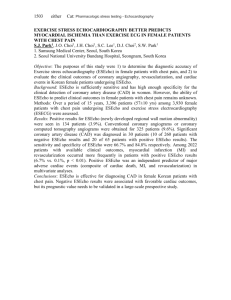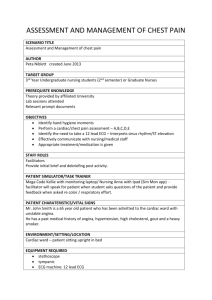SHARING GOOD PRACTICE Placement name and organization
advertisement

SHARING GOOD PRACTICE Placement name and organization The Chest Pain Royal United Hospital Bath. The learning tool we have devised is A student learning Pack. It is particularly useful for New students and nursing staff who have little or no cardiology experience. It allows an overview of cardiology, our patients and their journey. If you would like more information about this please contact The Chest Pain Unit 01225-821901 We do not wish you to adapt or use this material without consulting us first . Adapted from original version 2003, Sian Kerr 2005 Welcome to The Chest Pain Unit (CPU), we form part of the emergency directorate. We are a nine bedded short stay chest pain assessment unit. We take patients directly from the emergency directorate, after full assessment and having ruled out cardiac factors we then send them to the appropriate ward or home, the length of stay with us is meant to be 24 hours. The aim of this booklet is to guide you through your placement offering you ideas of what to see and who to spend time with, as well as being a work book for you to work through during your time with us. You will be given a main mentor who will be your assessor and two named associate mentors to facilitate your time with us. We hope you enjoy your placement with us!!!! We work the following shift patterns: Early: 07:00 – 15:00 Late: 13:30 – 21:30 Night: 21:00 – 07:30 During your time you will be rostered to work all of the above shifts, if you have any requests please speak to the person doing the off duty. Your shifts will reflect that of your mentors to optimise learning opportunity. You will be continuously learning in both an informal way through literature, mentors, learning pack, information boards and so on. There are also formal teaching sessions with the emergency department every Friday at 14:00, you will be encouraged to attend these. We have links with the following areas, if you wish you can spend some time in/on: The Coronary Care Unit (CCU) The Cardiac Ward The Cardiac centre The Emergency department (ED) The Medical Short Stay Unit (MSSU) The Medical Admissions Unit (MAU) We expect you to be familiar with the following: Signature Health and safety policy Infection control policy Manual handling Fire policy Hand washing procedure Also in each area you work make yourself familiar with: Duty arrangements Staff sickness procedure Visiting hours Date The Patient’s Journey The Emergency Department The Chest Pain Unit Blood Test: Troponin T +/Exercise Tolerance Test (ETT) +/Echocardiogram (ECHO) Home Cardiac Ward CCU Home This is a very simplified patient’s journey. Home A patient’s stay in the chest pain unit can be brief, however sometimes their stay in hospital is longer and they come into contact with a variety of people for various investigations, here is a spidergram of a patient’s journey and those individuals a medical patient might come into contact with. Ward Staff: Ward Sister Junior Sister/Charge Nurse Staff Nurse Health Care Assistant Housekeepers Consultants (Senior) House Officers Admission To Hospital Hospital chaplain Discharge Liaison Rapid Emergency Assessment Care Team (REACT) Bed Manager Site Manager Senior Nursing Roles: Modern Matron Head Of Nursing Family & Carers Community Staff: General Practitioner (GP) Practice Nurse District Nurse Pain Team . A Patient’s Care Journey Diagnostic Tests: X-ray MRI Scans CT Scan USS Blood Tests ECHO ECG VQ Scan Spirometry Dopplers ETT Specialist Nurses: Consultant Nurse Macmillan Nurse Stoma Care Dietician Respiratory Nutrition Diabetic Out Reach Team Stroke Team Cardiac Rehab Cardiac Nurse Practitioner Cardiac Rehab Nurse Inter-Professional Team: Physiotherapist Occupational Therapist Social Worker Pharmacist Medical Staff Speech & Language Dietician Outpatient In order to help you meet the objectives for this placement we have written some learning outcomes using the four domains to assist. Domain 1: Professional /ethical practice Learning outcome 1.3 * How would you support the individual rights of a patient and those of a group within the clinical setting, for example, consider: privacy and dignity confidentiality the use of cot sides the use of drug therapy in sedating a violent/aggressive patient the individual needs of the patient. You should also consider: the NMC code of conduct Clinical governance patient’s advocacy acts of parliament (e.g. mental health act etc) Write a small piece on one of the above issues and discuss it with your assessor/mentor. * When caring for a patient who comes from a different cultural/religious background consider what the differences are and how this affects the nursing care that they need. Write a care plan that the rest of the team can use when caring for this patient. Domain 2: Care Delivery Learning outcome 2.3: * * * * * What referrals are involved in patient care? How do you identify which patients need referring to members of the MDT? Consider how you would refer patients to members of the MDT. What documentation is used? What tools are used to assess patients? It is unlikely that you will have the opportunity to assess all the aspects that are identified in this outcome. Therefore to facilitate you achieving this outcome you can consider the following: * Work with the appropriate link nurse and add to the resource file. * Work in a different area, e.g. Accident and Emergency, where you will have the opportunity to carry out the necessary assessment. * Research how the assessment is performed in other areas, write a piece of feedback that could be utilised in the resource file. Learning outcome 2.4: * Identify a patient for whom you would like to do a care study. When you have chosen a suitable patient, consider the following Signs and symptoms of the patient How is the pain assessed and managed The treatment options Actual and potential problems and complications The goal of care – including rehab, physio, OT etc if appropriate Discharge information Health promotion Discharge destination Follow up appointments When a full assessment of a patient has been complete, identify a nursing problem that the individual has, create a care plan including planning implementing and evaluating of the care. Consider the psychological and physical aspects of the interventions/goals/treatment that the patient will undergo. Identify what sources of knowledge you used to achieve this. Upon completion present an aspect of the care study to a small group of staff. Learning Outcome 2.5: Not all of the competencies identified in this learning outcome can be achieved on CPU, therefore, you might consider working with the relevant nurse specialist or working in another area of the emergency directorate may give you the opportunity to learn and be deemed competent. Also working with the relevant link nurse, or researching a topic independently will help you gain understanding and competency in the relevant areas. Consider why skills are performed in a certain way, identify the relevant research. Are there any ways in which to improve on the current practice, for example essence of care groups and any matters arising from this. You could also critique existing policies and identify areas in which they could be improved. Feedback your findings to your mentor/assessor Domain 3: Care Management Learning Outcome 3.1 This learning outcome is all about risk management. * On the unit identify three risks and ways in which the risk can be reduced and/or eliminated. 1, 2, 3, * Identify resources that assist you in delivering safe care to patients. * The assessment of manual handling and pressure sore assessment should be covered in your case study. Discuss these with your mentor/assessor. Learning outcome 3.3 Identify the roles of others within the care team on the chest pain unit, identify those who you wish to work with to gain an over view of their role and constraints. Reflect upon this. Learning outcome 3.4 During your placement you will be expected to look after your own patients under supervision of your mentor, therefore you will be doing everything that is expected of a qualified member of staff from accurate documentation and handover to complicated drug calculations to problem solving. Domain 4: personal/professional development Learning outcome 4.2 Reflective practice is very important, you will be asked by your mentor how you will plan your day and care for your patient, you will also be asked to feed back throughout the day and at the end of the shift how everything has gone, and ways in which you could improve. You can use any of the reflective tools for this. We also encourage you to reflect on your own and in your work based learning days with your peers, on a weekly basis you will be asked to reflect on your week. You can use a recognized model of reflection for this or alternatively you can adapt your own. This will then be fed back to your mentor. The Chest Pain Unit Whilst you are with us you will develop other competencies. By the end of your placement you will be able to demonstrate the significance of observations on patient care. To help achieve this utilise the table below: Observation Respirations Temperature Pulse O2 Saturations Blood Pressure Fluid Balance Normal Parameters Reasons For & Signs & Symptoms Of Low Readings Reasons For & Signs & Symptoms Of High Readings Rationale For Performing Observation By the end of your placement you will also develop competencies in: Using bedside monitors including the use of dinamap Pulse oximetry Cardiac monitoring Using all documentation Handing over patients to colleagues Participating in admitting patients Participating in transfer of patients to other wards Caring for a patient with unstable angina Referring patients to other members of MDT Assessing patients pressure areas Planning care Procedure for obtaining patient’s notes and x-rays Procedure for self discharge Using thermometers Understanding the principles and practicalities of blood glucose monitoring Performing urinalysis Collecting a specimen of urine sputum stool Preparing a bed space for a patient Observing cannula for signs of infection Performing ECG’s The list goes on. Taking a 12 Lead ECG, the student will demonstrate: the ability to accurately and safely perform a 12 lead ECG. Understand the principles behind performing a twelve lead ECG You will be able to: Rationale explain why it is necessary to take an ECG to establish the rhythm to establish if pain is cardiac in origin to provide clinical evidence for diagnostic purposes explain when an ECG should be taken on admission when having chest pain if condition deteriorates/changes pre and post thrombolysis routine morning ECG (day 1-3) explain to the patient the task, why it is being taken and gain verbal consent must legally obtain informed consent help the patient to the correct position in a safe manner aware of safe manual handling techniques ensures optimal reading clean and prepare the skin ensures good contact between skin and contact = less electrical artifact apply the 10 electrodes and leads in the correct place to ensure correct reading from both vertical and horizontal planes minimize electrical artifact check lead placement ensures they are not pulling or lying over each other asks the patient to relax and lie motionless check calibration correctly label the ECG and file in notes Show the ECG to someone competent at ECG interpretation to enable interpretation using a standard recording useless without a name, date and time Achieved In order to be safe and competent when administering drugs, knowledge of the different drugs and various routes is needed, use the following tables to help Drug Group Examples Routes Effect Side Effects Diuretics Antihypertensives Anticoagulants Beta Blockers Statins Analgesics Anti-emetics Antibiotics Nitrates Drug Route IM IV SC Pros Cons Example Other things to consider when dealing with patient’s medications: What checks should you undertake prior to administering any drug to any patient? What sources can you use to obtain information about drugs? Why are some drugs locked away and signed out in a book? Which drugs are they? Explain the role of the student nurse in checking and administering medication in each of the following: - Oral administration - Intravenous drugs - Controlled drugs - Blood Transfusion What knowledge did you use to achieve this objective? To assist you build your knowledge of infections, consider: What is infection and what are the signs and symptoms? What is colonization? What is septicaemia? Discuss the route of transmission and the port of entry of infection? How can the transmission of infection be prevented? Explain what you understand by the term MRSA and describe the management of patient care. Take one area you have seen on the ward where infection control can be improved and look at it in greater depth. How can this be implemented in practice? QUESTIONS Never be afraid to ask questions Here are some for you: Anatomy and Physiology Describe the position and size of the heart in the body Name the layers of the heart wall and describe their purpose Describe the circulation and blood flow through the heart Describe the mechanism which transfers blood from the atria to the ventricles Describe the purpose of the valves in the heart Describe the purpose of the papillary muscles The Heart Label the diagram below: The Conduction system Label the diagram below: What properties does the tissue in the conduction system have? Describe the pathway of an electrical impulse through the heart in normal sinus rhythm Describe the representation of the P, QRS and T waves What does each millimetre on the ECG paper represent? Identify a patient with an arrhythmia. What is the rhythm? What is your understanding of this arrhythmia. What is the nursing care for this patient? Coronary Circulation Draw and label this diagram with the: Right coronary artery Left coronary artery Circumflex coronary artery Describe the purpose of the coronary arteries Which coronary artery supplies the sino atrial node? Which coronary artery supplies the atrio ventricular node? Which coronary artery supplies the inferior wall, anterior wall and posterior wall of the heart? How does knowledge of which artery is blocked affect our understanding of myocardial infarction? Coronary Heart Disease What is coronary heart disease? How does coronary heart disease form? What are the risk factors for coronary heart disease? What investigations would a patient have that was admitted with chest pain? What is the role of the nurse when a patient is admitted with chest pain? What are the roles of the rehabilitation nurse and the clinical nurse specialist? Identify a patient with coronary heart disease, what health promotion could you do for them and why? Angina What is angina? What is unstable angina? What are the signs and symptoms of unstable angina? What happens to the ECG in unstable angina? What investigations will diagnose angina? What are the drug treatments for angina and what advice would you give to a patient regarding these drugs? Myocardial Infarction What is a myocardial infarction (MI)? What are the signs and symptoms of a MI? What happens to the ECG in an acute MI? What is the significance of a raised enzyme (CPK, Troponin I, Troponin T)? What are the nursing priorities for a patient admitted with a MI? What is the main drug treatment for a patient admitted with a MI? What are the contraindications and potential side effects of this treatment? What is the nursing care of the patient during thrombolysis? What analgesics are used for the patient post MI and why are they used? Why is it important to ensure that the patient is pain free? What other groups of drugs are given to the patient post MI? Pericarditis What is pericarditis? What symptoms does the patient have with pericarditis? What usually happens to the ECG in pericarditis? What is the medical management for pericarditis? What is the nursing care of a patient with pericarditis? Heart Failure What is heart failure? What are the symptoms of heart failure? What is the medical management for a patient with heart failure? What is the nursing care of a patient with heart failure? Endocarditis What is infective endocarditis? What are the symptoms of endocarditis? What is the medical management for a patient with infective endocarditis? What is the nursing care of a patient with infective endocarditis? Aortic Stenosis What is aortic stenosis? What are the symptoms of aortic stenosis? What is the medical management of a patient with aortic stenosis? What is the nursing care of a patient with aortic stenosis? Rhythms What is sinus rhythm? What is sinus tachycardia? What is sinus bradycardia? What is the treatment for profound bradycardia? What is atrial fibrillation? What is the treatment for atrial fibrillation? What is ventricular tachycardia? What is the treatment for ventricular tachycardia? What is ventricular fibrillation? What is the treatment for ventricular fibrillation? What is asystole? What is the treatment for asystole? What is pulseless electrical activity or electromechanical dissociation? What is the treatment for pulseless electrical activity or electromechanical dissociation? Many Patients admitted to the chest pain unit have chest pain that is caused by something other problems than Acute Coronary Syndrome, these include: Pericarditis Myocarditis Pulmonary Embolism Chest Infection Hypertensive Heart Disease Valvular Disease Musculoskeletal Pain Anxiety Gastritis Oesophagitis Arthritis Glossary of terms & abbreviations you might come across ABG - arterial blood gas ACS - acute coronary syndrome AF - atrial fibrillation AMI - acute myocardial infarction Angio - angiogram/ angiography APTT - actual pro-thrombin time ASD - atrial septal defect CABG - coronary artery bypass graft CCF - congestive cardiac failure CHD – Coronary heart disease CPAP - continuous positive airways pressure CVP - central venous pressure ECG - electrocardiogram Echo - echocardiogram EPS - electrophysiological studies ETT - exercise tolerance test EMD - electromechanical dissociation ICD - implantable cardiac defibrillator IHD - ischaemic heart disease INR - international normalised ratio LVF - left ventricular failure (N)IDDM – (Non) insulin dependent diabetes mellitus NSF - national service framework (N)STEMI – (Non) ST elevation myocardial infarction PE – Pulmonary embolism PEA - pulseless electrical activity PPM - permanent pacemaker PTCA - percutaneous transluminal coronary angiogram r-tPA - tissue plasminogen activator SR – Sinus Rhythm Strep – streptokinase SVT – Supraventricular tachycardia TOE - trans-oesophageal echocardiogram TIMI – thrombolysis in myocardial infarction TNK - tinecteplase TNT – troponin T TPW - temporary pacing wire UAP – Unstable angina pectoris VE - ventricular ectopic VF - ventricular fibrillation VSD - ventricular septal defect VT - ventricular tachycardia Evaluation of Chest Pain Unit Student Pack This learning pack has been put together to support the student in practice and help to facilitate you in achieving your learning outcomes. As such it would be extremely helpful if you would spend some time in completing the following questionnaire. 1). Did you receive the pack on your first day? YES/NO Please comment…… 2). Did the pack aid you in writing your learning contract? YES/NO? Please comment…… 3). During your allocation, how often did you work with – Your Mentor Your Associate Mentors Additional Comments: 4). Did you visit any other areas during your allocation? Please list and explain how they helped/hindered learning. 5). Are there any other comments you would like to make about the pack? On completion please return this evaluation to your Mentor. Thank you








